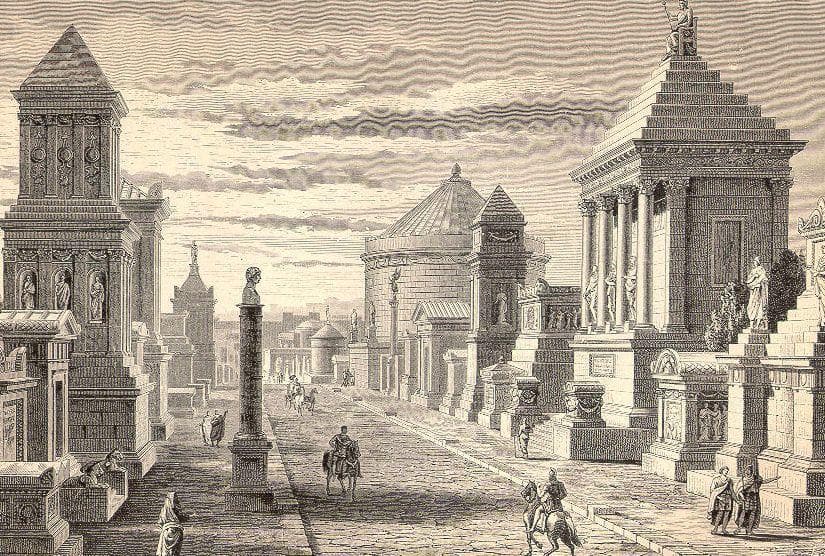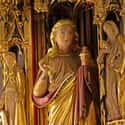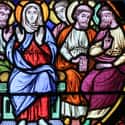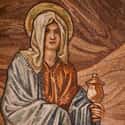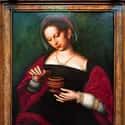-
(#1) For Centuries, A Skeleton In Southern France Has Been Rumored To Be Hers
Medieval legends tell the tale of Mary Magdalene fleeing Israel after Jesus's death and traveling to what is now France. Dan Brown and the scholars whose theories he co-opted - authors of the pseudo-historical book Holy Blood, Holy Grail - posited that she left with her kid or kids by Jesus and she raised them in France, creating what would become an early French dynasty.
Either way, a body reportedly belonging to Mary Magdalene resides at the Church of Saint-Maximin in the south of France. Recently, scientists and artists reconstructed the skeleton's face; the woman, whoever she is, has high cheekbones and a round face. Of Mediterranean descent, the lady was around 50 when she died. Future DNA tests could tell us where she came from.
Biological anthropologist Philippe Charlier told National Geographic:
“We are absolutely not sure that this is the true skull of Mary Magdalene. But it was very important to get it out of anonymity.”
-
(#2) The Best Evidence We Have Says She Was One Of Jesus's BFFs And Witnessed The Crucifixion
In most of the four canonical Gospels - Matthew, Mark, John, and Luke - Mary Magdalene is one of Jesus's most important disciples. In fact, in John, she is the first to see the door of Jesus's tomb rolled back; when she's crying in front of his tomb, Jesus reveals himself to her first, ahead of any of the apostles. She went to Peter and the rest to spread the Good News and share the Word. In Luke, a number of women, including Mary Magdalene, heard important words from angels, which they related to the rest.
So it's established Mary Magdalene was one of Jesus's most important confidantes after his Resurrection, someone he trusted intimately, in the Gospel tradition. As an editorial in Biblical Archaeology noted, Mary Magdalene was "an influential follower of Jesus" and a sort of female apostle - but there's no evidence in these texts of her being his wife or anything more than part of his entourage, albeit an important one.
-
(#3) The Idea Of Her As A Prostitute Is Just Pure Sexism
Mary Magdalene was not a prostitute, contrary to modern perceptions. But why do we think she was? The Gospel of Mark mentions Jesus cast seven demons or devils out of a woman named Mary; the Gospel of Luke calls her "Mary, also called Magdalene, from whom seven demons had gone out." And later Christian commentators conflated these two women, along with a mysterious woman with a bad reputation who anoints Jesus with ointment from an alabaster jar. There are a few other minor figures tied in here, too.
Originally, the ailment - personified by "demons" - cast out of Mary Magdalene might have been physical, but Christian commentators interpreted these ailments as moral failings, as James Carroll noted in Smithsonian. The sixth-century Pope Gregory I (later known as "the Great") typified the early Christian impulse to demonize or cast down some female figures in the Church. He delivered a series of speeches that not only rolled all the above female figures into one, but deemed Mary a repentant sinner from whom Jesus cast out all the bad things (AKA demons).
He got into the idea that Mary had once perfumed her private parts with the unguent and was a sex worker, but then wiped Jesus's feet with her hair and repented. Bart Ehrman, a prominent scholar of early Christianity, goes into great detail on his blog about why this is factually impossible in the Gospels - not to mention misogynistic!
-
(#4) Her Name Gives Us Some Important Details About Her, Including Her Fishy Past
What else do the Gospels tell us about the Magdalene? We know her name was Mary, but that's not unique. The aforementioned religious studies professor Bart Ehrman, an expert on early Christianity, wrote:
"[Mary] ...was one of the most popular names among Jewish women in the first century. Just within the New Testament, we know of six women who bore the name, including, for example, Jesus’s own mother. And this is out of a total of just 16 women named in the Gospels, so that six out of 16 are called Mary! In the first century, nearly one out of four Jewish women from Palestine whose names are known were called Mary."
"Magdalene" means "of Magdala," a town in Galilee, Jesus's home base. Magdala was a town known for its salted fish, which even Rome loved. Alternatively, Magdala is a reference to "migdal," or "tower" in Hebrew and Aramaic, and the town of Magdala might have originally been known as the "tower of" something.
-

(#5) People "Found" Jesus And Mary Magdalene's Family Sepulcher But It Was Debunked
In 1980, archaeologists came across an ancient tomb in a region of Jerusalem called Talpiot. The resulting sepulcher, aptly dubbed the "Talpiot Tomb," contained multiple ossuaries - essentially boxes of bones - of the deceased. The ossuaries in the Talpiot Tomb have some notable names inscribed on them: "Yeshua bar Yosef" (AKA Jesus, son of Joseph) and "Mariamne e Mara" (Mary, AKA the master). There are a few other familiar monikers in the sepulcher, like another Mary, Judas, son of Jesus, and Joseph, and early Christian symbology appears carved in the tomb's stone.
Although these names are very biblical - some posit that these figures must be our Gospel faves, especially since a "James, brother of Jesus" ossuary has also been found - it seems unlikely that these bones belong to the Jesus and Mary Magdalene we know so well. The ossuary evidence is pretty much all based on these people's first names, and scholars debate that "Yeshua" actually reads as such.
There are other names mentioned in the tombs, like Matthew, that don't fit into the narrative of Jesus's family. Not to mention that Jesus, Joseph, and Mary were some of the most popular names in Judea at this point, so the tripartite grouping might not have been uncommon.
The Christian imagery - Jonah emerging from the fish's belly - doesn't look much like Jonah and the fish, as it turns out. And finally, the Greek inscription next to it - which supposedly reads, "Divine Jehovah lift up! Lift up!" - doesn't actually say that. Instead, it appears that the box reads, "Here are bones. I touch them not. Agabus," with Agabus being the name of the deceased.
-
(#6) The Apocryphal 'Gospel Of Mary' Says St. Peter Got Jealous Of Her
There were lots more gospels and accounts of Jesus's life than just the four big ones floating around in the ancient world. Dubbed "apocryphal gospels," these texts "are written either in imitation of the genre 'gospel' as applied to the New Testament canon or in telling of events and sayings in the life of Jesus and his immediate circle of family and disciples." Meaning, therefore, that the traditions are perhaps just as valid, but they didn't make the final cut for some reason.
One such was the so-called Gospel of Mary, in which Mary Magdalene gets top billing, literally and figuratively. She takes on the Jesus-y preachy role in his absence, and the apostle Peter even gets jealous of how much Jesus loved Mary during his lifetime, admitting Christ told her things he didn't tell the other apostles. Peter tells her, "Sister, we know that the Savior loved you more than other women. Tell us the words of the Savior which you have in mind since you know them; and we do not, nor have we heard of them."
Peter grumbles to the other disciples, saying: "Did he then speak secretly with a woman in preference to us, and not openly? Are we to turn back and all listen to her? Did he prefer her to us?" Mary gets sad and asks Peter if he thinks she's making all this up; Levi then tells her Peter just has a quick temper and adds: "But if the Savior made her worthy, who are you to reject her?"
-
(#7) 'The Gospel of Philip' Calls Her Jesus's Companion, Not His Wife
Here's another apocryphal gospel, this one called the Gospel of Philip. This text states:
"There were three who always walked with the Lord: Mary, his mother, and her sister, and Magdalene, the one who was called his companion. His sister and his mother and his companion were each a Mary."
Mary Magdalene receives the title of "koinonos," or "companion" in Greek. There isn't a romantic connotation here.
The other big piece of evidence from Philip? Jesus is said to have kissed Mary Magdalene on the mouth. This seems damning, but earlier in the Gospel of Philip, the narrator discusses how a kiss is not a romantic gesture, but one of brotherhood and religious grace:
"It is from being promised to the heavenly place that man receives nourishment. [...] him from the mouth. And had the word gone out from that place, it would be nourished from the mouth and it would become perfect. For it is by a kiss that the perfect conceive and give birth. For this reason we also kiss one another. We receive conception from the grace which is in one another."
So everyone is kissing everyone at this time, a sign of religious companionship and bonds rather than romantic affection.
-

(#8) The So-Called 'Gospel of Jesus's Wife' Turned Out To Be A Forgery
Several years ago, Harvard professor Karen King of Harvard Divinity School made a startling proclamation: She deciphered an ancient scrap of papyrus that she was calling "the Gospel of Jesus's Wife." In it, Jesus specifically mentions his wife - although not her identity - which seemingly changes the biblical game.
But in 2016, an in-depth article in The Atlantic exposed the irregular chain of ownership of the papyrus. It eventually came out that the papyrus was a very clever forgery and King had been fooled. King herself has admitted that her career-making discovery has actually been anything but, meaning that this so-called evidence never existed in the ancient world and was a much more modern invention.
-
(#9) She Got Conflated With Even More Marys In The Gospels
It's already been mentioned that Mary Magdalene is associated with another Mary who had seven devils, as well as a penitent with an alabaster jar. But there are so many other Marys in the Bible besides Mary Magdalene and the Virgin Mary, and our Magdalene gets conflated with a few of those ladies.
The Gospel of John mentions a woman named Mary anointing Jesus, but Bart Ehrman contends this is Mary of Bethany, not Mary Magdalene. Mary of Bethany was another of Jesus's followers and the sister of Lazarus, whom Jesus resurrected. These two Marys get mashed up with various anointers throughout, making one big Mary mess.
-

(#10) Pieces Of Mary Magdalene's Body Are Venerated As Relics Across The Mediterranean
Mary Magdalene didn't only go to France; she also reportedly traveled to lots of other spots around the Mediterranean and her relics - portions of her skeleton - are revered across Europe. There's the aforementioned Church of Saint Maximin in southern France, where her skull and her bones are venerated. Mary's relics also reportedly reside at Vézelay Abbey in northern France.
Eastern Orthodox tradition relates that Mary also went to Ephesus, an ancient city in modern Turkey. As a result, her relics, including her alabaster jar, wound up there, too, buried at the foot of the Column of Constantine by Constantine's mother, St. Helena. Mary's left hand also reportedly resides at Simonopetra Monastery in Greece
-

(#11) There Is No Evidence Of A "Secret Gospel" Or Secret Society Hiding Her Body Or Bloodline
Despite the fact that Dan Brown and conspiracy theorists have espoused these ideas, there is no provable evidence that Mary Magdalene had any children, that a secret society is hiding her descendants, or that a coded "lost gospel" exists depicting her marriage to Jesus. For one, there is no physical evidence of Mary Magdalene giving birth.
Scholars have debunked the existence of the so-called Priory of Sion as an organization aimed at protecting the secret existence of Jesus and Mary's descendants and their holy bloodline. And the idea of a secret gospel is false; the proponents of this theory are actually just making up a convenient narrative about a text that's been around for years.
-
(#12) She Was One Of Several Powerful Women In Jesus's Entourage
Mary Magdalene wasn't the only important woman who followed Jesus. Sure, there was the Virgin Mary and Mary of Bethany, but there are more ladies.
As Bart Ehrman notes:
"We know from the letters of Paul – from passages such as Romans 16 – that women played crucial leadership roles in the churches: ministering as deacons, leading the services in their homes, engaging in missionary activities. Paul speaks of one woman in the Roman church as “foremost among the apostles” (Junia in Rom. 16:8). Women are also reputed to have figured prominently in Jesus’ own ministry, throughout the Gospels. That may well have been the case, historically."
There's also Joanna, wife of Chuza, who was an important man - steward in the household of King Herod Antipas. So Jesus had influential ladies amongst his followers.
New Random Displays Display All By Ranking
About This Tool
Mary Magdalene has always appeared in Christian legends as a historical figure saved by Jesus. It is said that she may be the closest faith companion of Jesus in the world, or that she is the best pith of Jesus who has not been recorded in official history. But there has been controversy over the authenticity of Maria Magdalene and her deeds in history.
There is no evidence to support the identification of Mary Magdalene as a prostitute or a guilty woman, despite popular descriptions of her. It is believed that Mary Magdalene witnessed most of the events approaching the crucifixion of Jesus. The random tool explained 12 details of Mary Magdalene that you must be interested in.
Our data comes from Ranker, If you want to participate in the ranking of items displayed on this page, please click here.

